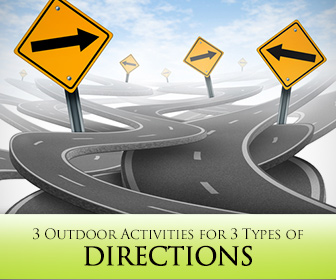
Directions are something every ESL teacher will have to address at some point.
Asking, understanding, and giving directions is such an important skill that it really can’t be overlooked. As a result, a plethora of directions activities are available on almost any ESL or EFL website. Some are good and some are not so good, but one thing they all have in common is that the students stay inside. Now, there are obvious benefits to keeping the kids inside, and working with maps will certainly help them start to get a firm grasp on the language they need to ask directions. But nothing really prepares students like actually using the language out in the world. Not every teacher has the good fortune to be allowed to take their students outside, but for those who do, here are three great activities for getting your students using English directions in real time.

Enjoy Real Life Finding Your Way Activities
-
1
Block by Block
This is one of the easiest activities to create. All you need is a map of the neighborhood (printing a Google map works just fine) and a familiarity with the area around your school. This will be a group project and the teacher must decide if they want every group to complete a different route, or it they want to send all of the groups on the same route and make it a timed event. In the latter case, allow at least five minutes between groups departing to prevent a foul up along the way. My preference is for sending them all out on different routes. It makes sure that there they don’t just run along and follow one group after another. It forces each group to figure out its own set of directions.
Depending on the level of your class there are two ways to prepare. Either give them a sheet of written, block-by-block directions that they must follow or give them a map with a series of points indicated on it and have them create the most efficient route to visit all of them. Once you are sure that they know where they are going turn them loose in the neighborhood to follow the directions. In most well wired countries, students will have cell phones with cameras. For each location, select a specific business or landmark and require that the students take a photo of it to show the teacher when they get back. They must have all the photos in the correct order when they arrive back at the school.
-
2
Landmarks
In some ways this is very similar to the above exercise but it practices a different kind of directions. This also requires a map and knowledge of the neighborhood on the part of both teachers and students. Create a list of major neighborhood landmarks and locate small lesser known shops or markers near them. It is these lesser known places that your students will have to locate and document in some way. Each group will get a list of landmarks in the neighborhood and with each landmark, directions to get to the smaller location nearby. For example the landmark might be the bank. The directions that the group are given would be something like the following: go to the bank. Locate the small restaurant with a red sign that is kitty-corner (or above, around the corner from, just to the right of, just up/down the block from) to the bank and on the second floor. From here, this activity plays out the same way Block by Block, with the various groups competing with one another to complete their list of destinations first.
Extension: Rather than just giving them the names of landmarks such as banks, create a jigsaw style puzzle that they must solve before they can go out and find the landmark. To do this, each member of the group would get a set of numbered clues. All the number one clues would lead to the same thing, so they can read the clues to one another and try and work out what the place could be. Taking a bank as an example, student A’s first clue could be ‘People would love to rob me’, student B’s first clue could be ‘I have a very big safe’ and so on.
-
3
Large Scale Made Small
Finding a way to practice large scale directions, such as would be used between cities, is very difficult and obviously falls in the category of how can I approximate the skills they need while still making a fun activity? This activity necessarily draws on the landmark style instructions as well as practicing compass based directions. Designing this activity requires that the teacher spend quite a bit of time finding suitable landmarks and that they understand the layout of the neighborhood. Identify several landmarks, crossroads, or other distinct locations and mark them on the map. Create a set of directions from the school. These should take the form of directions and distance (ie. Go northwest 850 meters). If the students have access to compasses you can make these directions even more specific with degree values etc. For low level classes simply continue in this vein, giving new directions from the new location to different selected landmarks. Give the students a scale map of the neighborhood and make sure they have a ruler. They use these to locate their destination on the map and then go to it.
For higher level classes, and classes where there is more time, include a small landmark based instruction at each location. For example if the first instruction takes them to an elementary school, the second might be to locate the market with a green sign. From there, go southeast 200 metres. In this way, the students must take the map, ruler, and directions with them. Once they reach the first destination they have to search for the landmark. Then they must locate the landmark on the map, read the next compass based direction, draw that on the map, and head off to their new destination. As you can see, this activity takes a lot of class time, but the students seem to enjoy it. However, it is labour intensive so do not make these courses too long or the students will lose interest. Three to five major locations seems to be about right.
Obviously, all of these are only the activities and none of them will work if the teachers have not first taught the necessary vocabulary and phrases to their students.
To emphasise listening skills with higher level classes, read the directions out to the groups rather than handing them sheets of paper with written directions. Students love these activities because they get to head outside and run around. It’s like free time for them, but they are actually practicing using the language in an applicable manner. Also, when they see how useful, and challenging, directions can be, they start to realize that this might actually be a useful ability to have and tend to make a greater effort to understand the necessary language. Beyond that, it is always fun to watch the kids charging off and racing back having completed their tasks, so sit back and share in the fun.
P.S. If you enjoyed this article, please help spread it by clicking one of those sharing buttons below. And if you are interested in more, you should follow our Facebook page where we share more about creative, non-boring ways to teach English.







